.jpg)
The above image is sourced from : http://www.circusmuseum.nl/eng/ search under Wendling
Collectie
Circusarchief Jaap Best
Tekst achterzijde foto
Televox. Der Maschinen Mensch. Erfinder: Ing. Eugène Wendling. 1930. Grand Hotel et surselva Waldhaus-Films
Jaar vervaardiging
1930
Personen
Wending, Eugène
*Not to be confused with Wensley's Herbert Televox in America.
from Chapius Droz book AUTOMATA
There is the robot, also called " Televox," made by the [Swiss] engineer Eugene Wendling and exhibited in the Knie Circus.
It is made to look like a giant in human shape and is constructed of sheet steel; it first apppears seated with its arms hanging down stiffly.
"The mechanism is comparatively simple. When the current is switched on, the eyes become luminous. Two neon bulbs light up showing that the mechanism is about to work.
"Three photo-electric cells concealed in various parts of the chest operate amplifiers and motors, which are completely independent of each other, so that three separate mechanisms can be distinguished in the robot.
"The operator holds a small electric flashlight in his hand and directs the luminous beam from it for a moment on one or other of the cells. The mechanical man responds to the action of the first cell by getting up from his seat, while the subsequent operations of the other cells, which work independently of each othermake him move his head and his arms."
The robot stands up suddenly, looking to its left, then to its right, and gently lifts its right arm, which holds a pistol. After a moment's delay, during which it seems to listen, it directs its glance towards one of the corners of the room, waves its arm and fires. This performance always produces a lively reaction from the public.
In Strehl's "The Robots are Among Us" p122
"One of the most artistic and famous robots was Televox, constructed by the Swiss engineer Wendling. Some years before the last war he demonstrated his Robot, whose complicated interior mechanism was controlled by a light-ray transmitter set up a few yards away, on the variety stage of Europe. The reception station inside the figure was a photo-cell which was influenced by the light ray, and thereby started a motor. Televox could move arms and legs like a normal human being, light lamps, hoist flags, shoot, control signals – and make a speech before a distinguished audience."
A recently discovered magazine article from 1936 shows the metallic "Mekko" but called "Televox"!
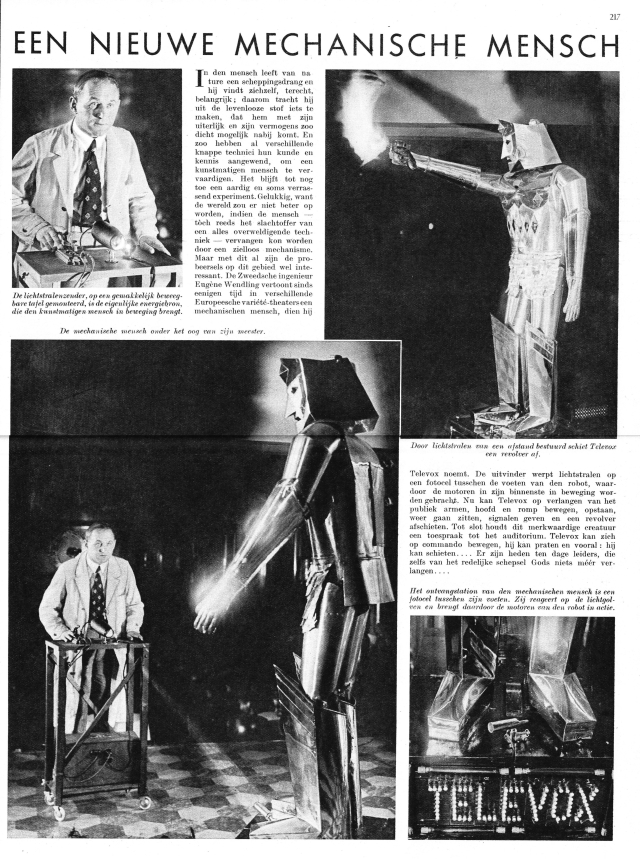
You can see Wendling directing the flashlight to the photo-electric cell located between Televox's feet.
Source: Katholieke Illustratie 1936
Een nieuwe mechanische mensch.
In den mensch leeft van nature een scheppingsdrang en
hij vindt zichzelf, terecht, belangrijk ; daarom tracht hij uit de levenlooze stof iets te maken, dat hem met zijn uiterlijk en zijn vermogens zoo dicht mogelijk nabij komt. En zoo hebben al verschillende knappe technici hun kunde en kennis aangewend, om een kunstmatigen mensch te vervaardigen. Het blijft tot nog toe een aardig en soms verrassend experiment. Gelukkig, want de wereld zou er niet beter op worden, indien de mensch — toch reeds het slachtoffer van een alles overweldigende techniek — vervangen kon worden door een zielloos mechanisme. Maar met dit al zijn de probeersels op dit gebied wel interessant. De Zweedsche ingenieur Eugène Wendling vertoont sinds eenigen tijd in verschillende Europeesche variété -theaters mechanischen mensch, dien hij
Televox noemt. De uitvinder werpt lichtstralen op een fotocel tusschen de voeten van den robot, waardoor de motoren in zijn binnenste in beweging worden gebracht. Nu kan Televox op verlangen van het publiek armen, hoofd en romp bewegen, opstaan, weer gaan zitten, signalen geven en een revolver afschieten. Tot slot houdt dit merkwaardige creatuur een toespraak tot het auditorium. Televox kan zich op commando bewegen, hij kan praten en vooral : hij kan schieten…. Er zijn heden ten dage leiders, die zelfs van het redelijke schepsel Gods niets méér verlangen….—-Google translation——-
A new mechanical man.
Man lives in a natural and creative urge he finds himself, rightly, is important, so he tries from lifeless matter anything to make him with his looks and abilities as closely as possible approaches. And so have been pretty different technicians used their skills and knowledge in order to manufacture an artificial man. It remains to date a nice experiment, and sometimes surprising. Fortunately, because the world would not be better if the man – but already the victim of an all overwhelming technology – could be replaced by a soulless mechanism. But all these are interesting experiments in this field. The Swedish engineer Eugene Wendling has been some time in various European cabaret theaters mechanical man whom he calls Televox. The inventor throws light on a photocell between the feet of the robot, making the engines in his heart in motion. Now Televox at the request of the public arms, head and torso move, stand up, sit down, and signals to firing a gun. Finally, this strange creature a speech to the auditorium. Televox can move on command, he can talk and above all: he can shoot …. There are leaders today, even the reasonable creature, God's desire nothing more ….
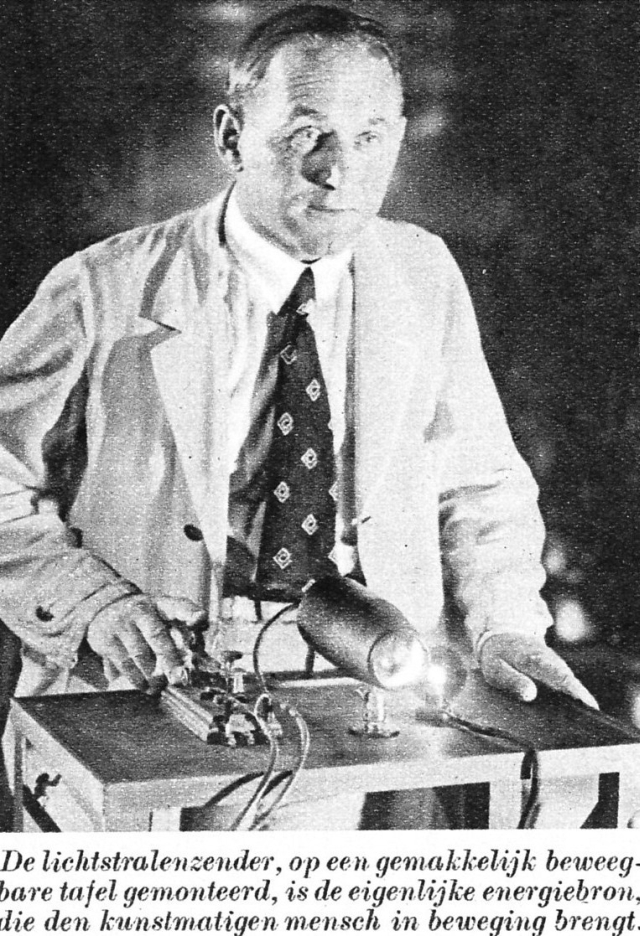
The light transmitter, mounted on an easily movable table, the actual energy that the artificial man in motion.
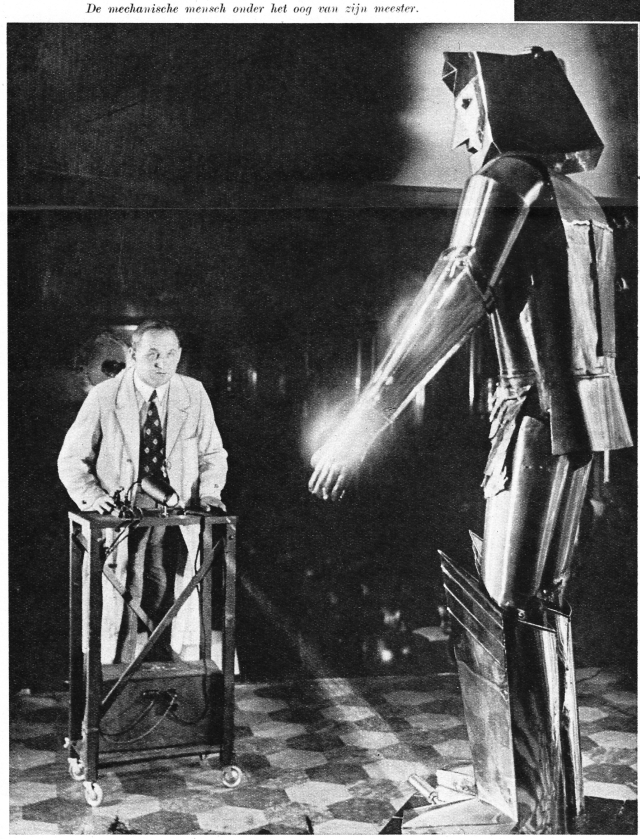
The mechanical man in the eye of his master.
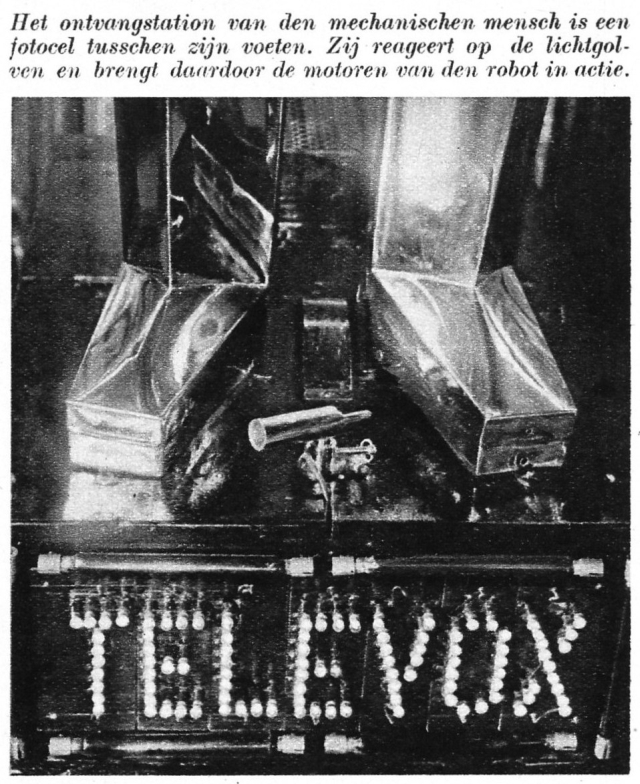
The receiving station of the mechanical man is a photocell between his feet. He reacts to the light waves and thus brings the motors of the robot in action.
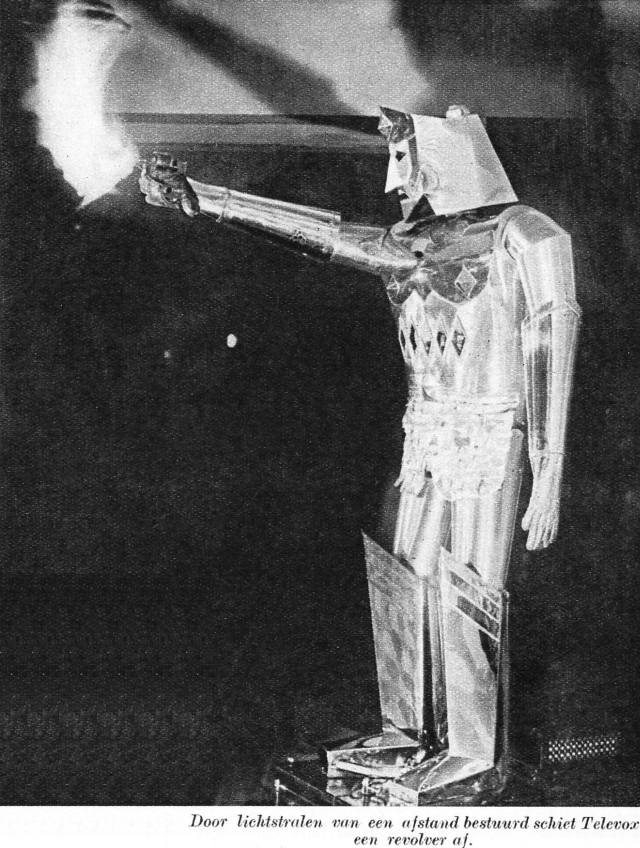
By light rays for remote-control Televox shoots off a gun.
Research to date indicates that Wendling's Televox was the first to include the firing of a gun in its act.
See also Wendling's later Mekko and Firato in 1958. 